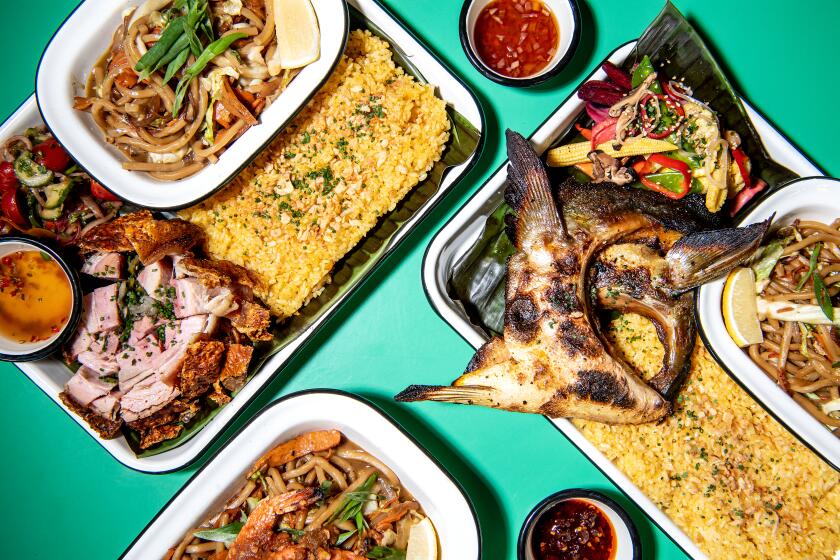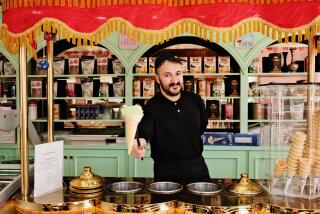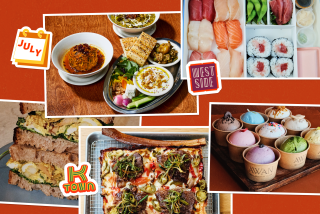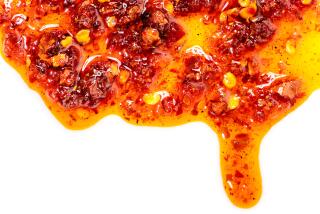Seeing ube everywhere? Two desserts to try now

Jenn Harris takes us to Pasadena for her favorite ube desserts — turon filled with ube custard, and ube malted crunch ice cream.
How to tell if a particular flavor has entered the mainstream American culinary vernacular:
Spot said flavor at Trader Joe’s in the form of cookies, chips and/or ice cream.
Have your dad, who was previously unfamiliar with said flavor, ask if you’ve tried the flavored cookies, chips and/or ice cream at Trader Joe’s.
Find said flavor as a nonalcoholic drink option at a Las Vegas buffet.
Ube, the purple yam found all over Southeast Asia, is a common ingredient in many sweet and savory desserts and snacks in the Philippines. In the U.S., ube desserts had been mostly exclusive to Filipino restaurants, bakeries and Asian markets. But in the last year or so, I’ve found the subtle, earthy vanilla flavor everywhere, as an ube coconut beverage at the Wynn Las Vegas buffet, as a mochi pancake mix, cookie flavoring and ice cream at Trader Joe’s, and as the star ingredient in desserts all over Los Angeles.
Christian Esteban, who runs Chaaste in Pasadena with his family, laughs when I ask him about ube making its way into American grocery stores and restaurants.
“Ube in the Philippines is second nature,” Esteban says during my recent visit to his market. “They have all kinds of ube, from rice cakes, they come in little candy bars, it’s ube everything out there.”
Ube custard-filled turon at Chaaste Family Market
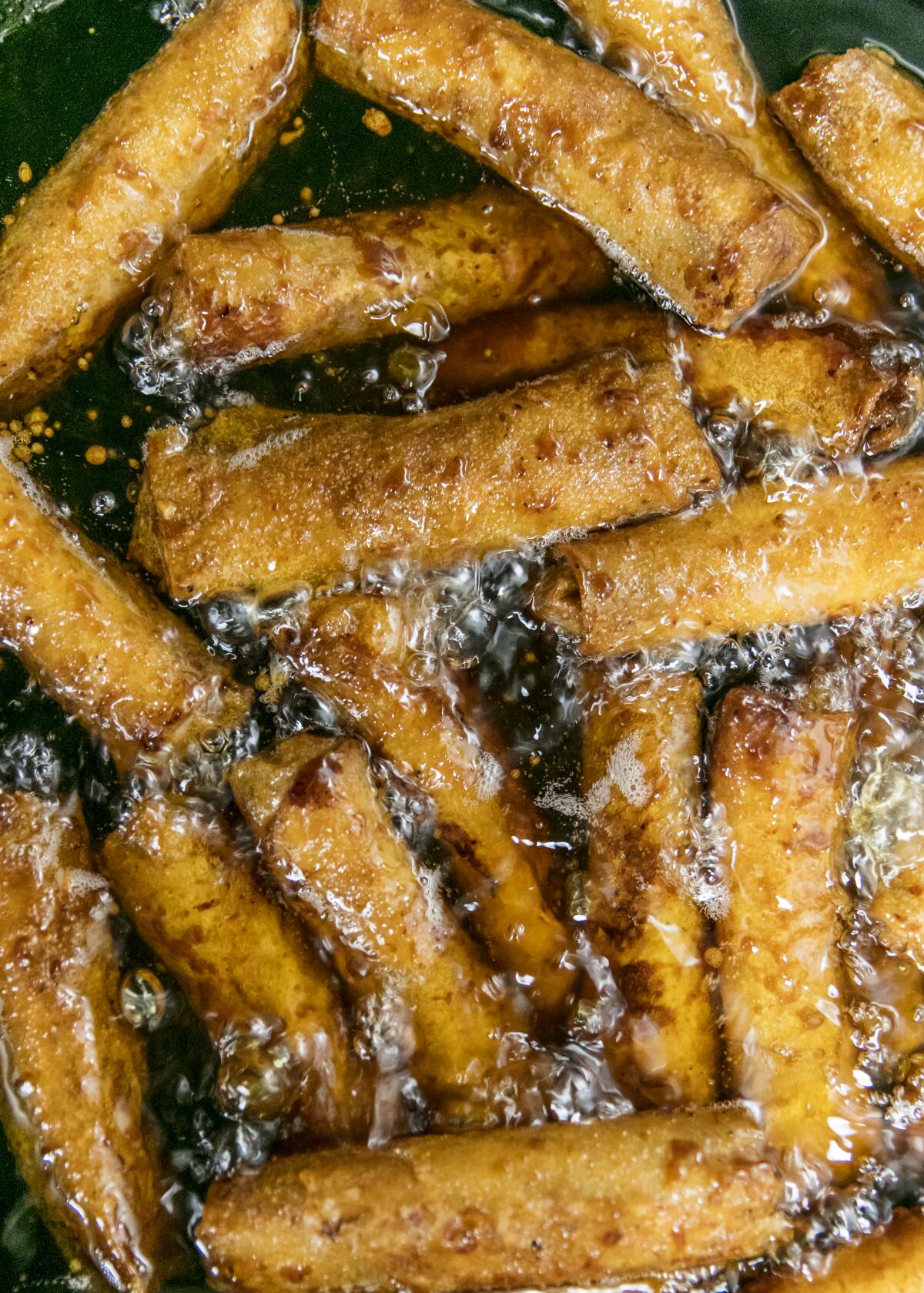
Chaaste is a Filipino market and cafe where you’ll find refrigerators full of frozen desserts and drinks and a hot bar with everything from lumpia to pancit and curry. There’s an abundance of ube products in the market, including cookies, crackers and prepared ube flan. If you’re in the mood for halo halo, there’s ube ice cream tucked into the layers of jelly, sweet beans and shaved ice. I’m happy to indulge in them all, but my favorite ube item at the moment is the custard-filled turon.
Pastry chef Ariel Schindledecker says that among all the turons (banana lumpia), including churro rolled in cinnamon sugar, jackfruit and Nutella, ube custard is the bestselling dessert at the market.
“I think it’s because of the ube craze going on right now,” she says.
At Kuya Lord in Hollywood, Lord Maynard Lllera seamlessly transitions his delicious, personal Filipino cooking from pop-up to restaurant.
I watch as Schindledecker whips up a batch of the custard with egg yolks, cane sugar, coconut milk, flour and corn starch. She adds most of the ingredients, including a few dashes of ube extract, without measuring.
“We tantsa, tantsa here,” she says. “Tantsa in Filipino culture … Filipinos don’t really use measuring cups, they just feel it,” Christian adds. “That’s tantsa. [Ariel] learned the Filipino way.”
Christian’s mother, Susan, who opened the shop in 1987, taught Schindledecker how to make the turon. She sprinkles raw banana with sugar, then wraps it in pastry sheets sourced from the Philippines. The banana needs to be just ripe enough to transform into a soft, custard-like filling. Christian says that he, his mother, Schindledecker and his brothers simply know when a banana is ready. Once deep-fried, the rolls appear lacquered with a deep brown glaze that gives the turon an extra crunch.
“The sugar you see on the outside is not a glaze,” explains Schindledecker. “It’s actually the sugar that comes out in the process of cooking it from the banana and the sugar.”
The wrapping technique, developed by Susan over decades, allows the sugar to permeate the shell, creating what seems like a a wet sugar glaze around the exterior.
Once the turon are fried, Schindledecker cuts them in half and uses a syringe to inject the finished ube custard into the centers. The Barney-the-dinosaur-purple filling spills out the top of the roll, creating big globs of smooth, cool, ube custard up against the banana. The effect is similar to a good cream-filled doughnut, with the vanilla notes in the ube balancing the sweet banana and caramelized sugar-laced shell.
“The turon is what we are famous for,” Schindledecker says. “I’ve only tried a few other places, but I feel like this one is the best.”
I’d have to agree with her.
Ube malted crunch ice cream from Wanderlust Creamery
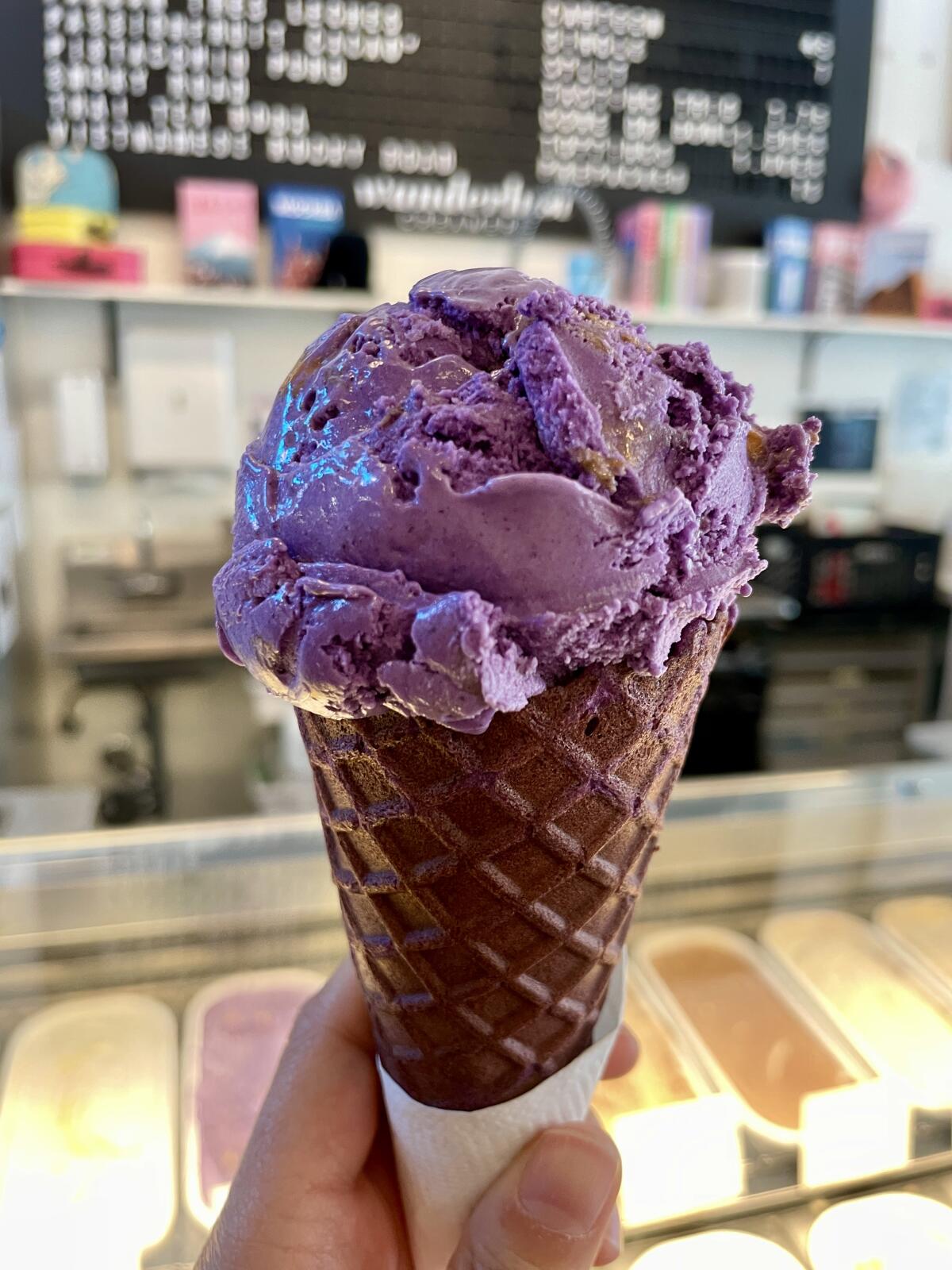
When Wanderlust Creamery owner Adrienne Borlongan was a kid, her mother would buy her two cakes each year for her birthday. One was a vanilla or chocolate cake and the other was ube.
“The kids at school would not want to touch the purple cake because they thought it was weird,” Borlongan says. “They would say, ‘Oh, it tastes like a melted candle.’ I think it’s delicious.”
Now, Borlongan says she can almost guarantee that every kid at her Los Angeles scoop shops will have a purple rim around their mouths from her ube malted crunch ice cream.
Though she’s known for creating flavors such as sticky rice and mango, yuzu creamsicle and Royal Milk Tea-ramisu, the ube malted crunch is the one that took Borlongan the longest to develop. And she only decided to incorporate ube into her flavor lineup after her parents insisted.
“I got all this flack from them,” she says. “‘You’re opening an international ice cream shop and you don’t have one Filipino flavor in the case? The least you can do is ube.’”
But she didn’t just want to make a purple ice cream and call it ube. She needed to find the right balance of flavors and textures that wouldn’t overpower the delicate flavor of the yam. She also wanted to use actual ube in addition to the extract.
“Actual ube, the real vegetable, doesn’t taste like this [extract] at all,” she says. “Fresh ube is not available stateside. All of the flavor people most associate with ube when it comes to mind is from extract, so I have to use extract.”
I think back to the ube desserts I’ve had over the years. The flans, cakes, puddings, ice creams and custards all had a distinct nutty, earthy taste with hints of sweet vanilla.
After months of development, Borlongan landed on an eggless custard base that incorporates a preserved ube jam, ube extract, malted milk and shards of dehydrated malted milk powder. It’s a formula that ensures ube is the dominant flavor. It’s also an homage to the Thrifty Chocolate Malted Krunch ice cream she frequently ate as a kid.
“I think this flavor is a reflection of growing up with a different culture than just American,” Borlongan says. “I feel like this brings everything together in an ice cream flavor.”
The malted milk acts as a flavor enhancer for the ube, the toasty, milky powder coaxing the yam to the forefront. Borlongan folds in the dehydrated milk powder for a familiar crunch and even more of that malted milk flavor. Depending on how long ago your ube malted crunch was prepared, your bits of dehydrated milk powder will go from crunchy to chewy as it melts into the purple ice cream. The best scoops incorporate both textures, like the cracked tops of a blondie or brownie floating in the ice cream.
If you’d like to guarantee the crunch in your scoop of ube malted crunch, Borlongan has a new cookbook out that includes the recipe.
“I’m actually very happy that this is happening,” she says of the current ube craze. “I wish this had happened when I was a kid ... it makes me happy. The kid in me, it makes me smile.”
Where to try a stellar ube dessert
Chaaste Family market, 296 Allen Ave., #3, Pasadena, (626) 796-1527, chaastefamily.com
Wanderlust Creamery, multiple locations, wanderlustcreamery.com
More to Read
Eat your way across L.A.
Get our weekly Tasting Notes newsletter for reviews, news and more.
You may occasionally receive promotional content from the Los Angeles Times.
